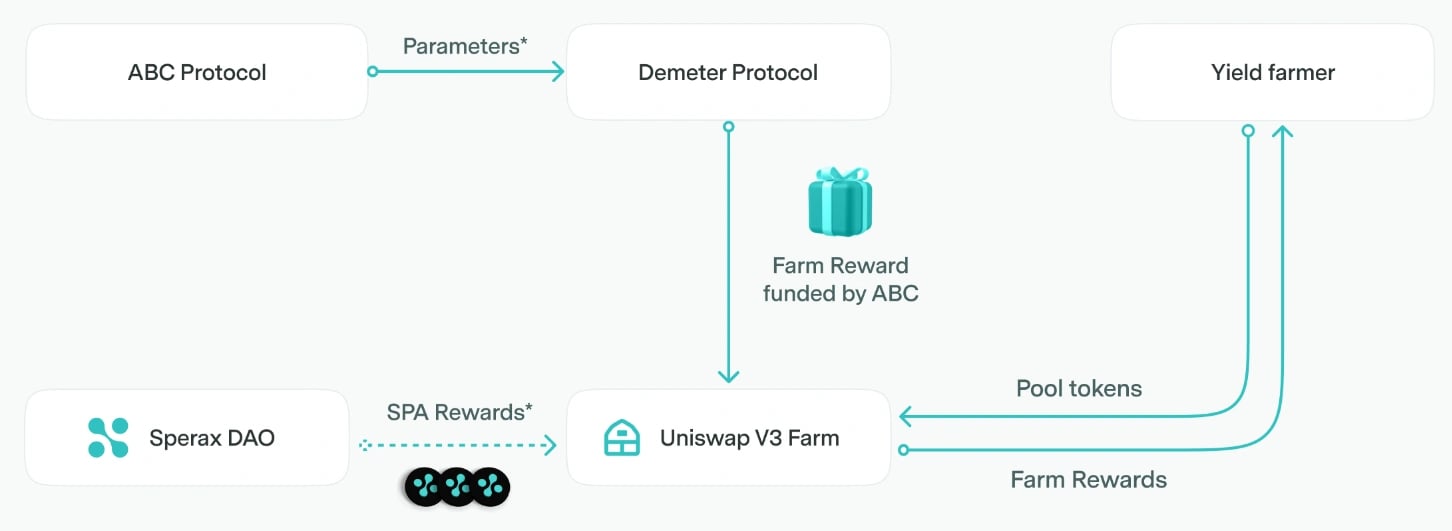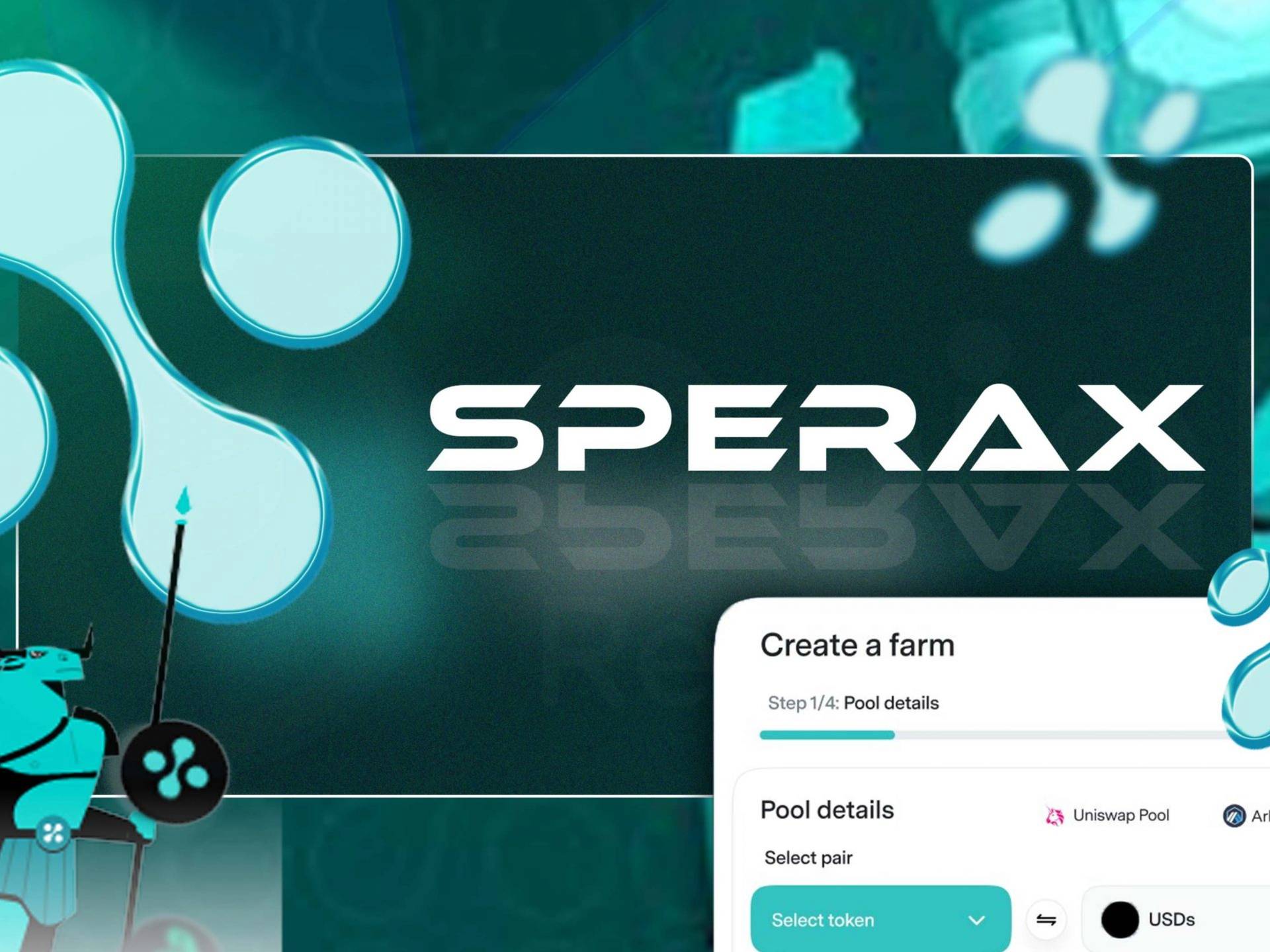위키 구독하기
Share wiki
Bookmark
Sperax
Sperax
스퍼랙스(Sperax)는 완전 담보, 자동 수익률을 제공하는 2계층 알고리즘 스테이블코인인 USDs(SperaxUSD)를 기반으로 하는 스테이블코인(stablecoin) 프로토콜입니다. [1] Arbitrum(아비트럼) 상에서 작동합니다.
개요
Sperax는 2020년에 출시되었으며, 이후 2021년 12월에 출시된 자동 수익률 안정화 코인 USDs를 만드는 것으로 전환되었습니다. USDs는 탈중앙화 금융(DeFi) 분야에서 기존 안정화 코인의 한계를 해결하고자 하는 안정화 코인입니다. CDP 안정화 코인처럼 100% 담보 모델의 장점을 가지면서, 법정화폐 기반 안정화 코인과 같은 확장성 이점도 추가하여 다양한 안정화 코인 설계의 장점을 결합합니다. 이는 USDs를 매우 확장 가능하고, 신뢰할 수 있으며, 탈중앙화되도록 하기 위한 온체인 기반 상환 설계를 통해 달성됩니다. [2][3]
SPA 토큰
Sperax 생태계는 SPA로 알려진 거버넌스 및 가치 축적 토큰을 활용합니다. SPA를 보유한 개인은 토큰을 스테이킹하여 veSPA(Vote-Escrowed SPA)를 받을 수 있으며, 이를 통해 스테이킹 보상을 받고 Sperax 거버넌스에서 투표권을 통해 프로토콜의 수익을 관리할 수 있습니다. 현재 오프체인 거버넌스가 활성화되어 있으며, veSPA 보유자로 대표되는 커뮤니티는 USDs 프로토콜의 수익률 전략, 적격 담보물, 새로운 제품 기능 등 다양한 측면을 제어할 수 있습니다. [2]
SPA 게이지
Demeter.sperax.io에서 찾을 수 있는 SPA 게이지는 Arbitrum 유동성을 강화하고, 신흥 프로젝트를 지원하며, Arbitrum 커뮤니티를 보호하도록 설계되었습니다. 이 도구는 USD 거래 쌍에 SPA 토큰을 분배하는 보상 메커니즘을 도입합니다. SPA 게이지는 또한 모든 Arbitrum DAO가 USD를 사용하여 토큰의 온체인 유동성을 시작하거나 향상시킬 수 있도록 합니다. USD와의 거래 쌍을 생성함으로써 프로젝트는 게이지에서 SPA 보상을 자동으로 받을 수 있습니다. [12]
SPA 게이지는 매달 미리 정해진 양의 SPA를 할당합니다. veSPA(스테이킹된 SPA) 보유자는 매주 투표에 참여하여 USD 풀에 대한 SPA 보상이 어떻게 분배될지 결정합니다. 또한 특정 풀에 대한 투표를 대가로 DAO의 보상을 받을 수도 있습니다. veSPA 보유자는 매주 투표에 참여하여 SPA 보상 분배를 결정하고, 투표를 통해 풀의 "게이지 가중치"를 높입니다. 또한 SPA 게이지 시스템을 통해 DAO는 특정 게이지에 대한 투표를 대가로 veSPA 보유자에게 보상을 제공할 수 있습니다. [12]
주요 기능
- 자체 보관: 중앙화된 기관과 관련된 위험을 제거하고 자산을 보호합니다.
- DeFi 생태계 접근: 상호 운용성과 공유 유동성을 증진하는 분산형 금융 생태계에 참여하여 사용자의 토큰을 개발자와 투자자에게 공개합니다.
- 자동화된 시장 조성: VC, 시장 조성자 또는 중앙화된 거래소에 의존하지 않고 공정한 토큰 출시를 실행합니다. 수수료는 시장 중개자가 아닌 커뮤니티로 돌아갑니다.
- 다중 DEX 지원: SPA 게이지는 DEX와 무관하므로 모든 DEX에서 USD 페어에 연결할 수 있습니다. 두 번째 통합은 Camelot과 함께 진행되어 Arbitrum 생태계 내의 여러 DEX에서 공정한 출시를 가능하게 합니다.
게이지 참여
DAO는 두 가지 방법으로 SPA 게이지에 참여할 수 있습니다: [12]
- Demeter.sperax.io를 통해 USDs 또는 SPA 페어를 출시합니다.
- 제안(SIP)을 제출하고 사용자 지정 전략 또는 풀에 대한 스냅샷 투표에 참여합니다.
자동 수익
자동 수익은 USDs 스테이블코인의 기능으로, 사용자는 어떠한 조치도 취하지 않고 보상을 받고 지갑 잔액을 늘릴 수 있습니다. 이 기능은 USDs 발행에 사용된 담보를 사용하여 다른 감사된 DeFi 프로젝트에 배포하여 수익을 창출합니다. 보상 토큰 및 풀의 스왑 수수료 형태의 수익은 USDs 보유자와 SPA 스테이커에게 공유됩니다. 수익의 50%는 새로운 USDs를 발행하고 지갑에 USDs를 보유한 모든 사람에게 배포하는 데 사용되므로 가스 비용 없이 수익을 얻을 수 있는 방법입니다. 목표 수익률은 연 11%이며, 그 이상의 추가 수익은 시장 하락 시 APY를 지원하기 위해 저장됩니다. 스테이킹된 USDs는 자동 수익 배포 대상이 아니며, 비계약 주소 또는 외부 소유 계정(EOA) 지갑의 USDs 보유자만 7일마다 정기적인 자동 수익을 받습니다. [4]
수익률 전략
커뮤니티에서 제안하고 잠재력과 위험 수준을 평가하는 다양한 수익률 생성 방법들이 있습니다. 그런 다음 커뮤니티는 담보를 배치할 풀이나 팜에 대해 투표합니다. 현재 수익률 생성에 사용되는 전략은 다음과 같습니다: [4]
- Saddle - vault-core의 FRAX와 USDC를 Saddle FRAX-USDC-BP 풀에 예치하고 LP 토큰을 Saddle gauge에 스테이킹합니다. 이 전략은 FRAX와 USDC의 수수료와 SDL의 팜 보상을 통해 수익을 창출합니다.
- Frax - vault-core의 FRAX와 VST를 Curve FRAX-VST 풀에 예치하고 LP 토큰을 Frax gauge에 스테이킹합니다. 수익은 FRAX와 VST의 수수료와 FXS 및 VSTA의 팜 보상을 통해 창출됩니다.
- Stargate - vault-core의 USDC를 Stargate USDC 풀에 예치하고 LP 토큰을 Stargate 팜에 스테이킹합니다. 수익은 USDC의 수수료와 STG의 팜 보상을 통해 창출됩니다.
- Aave - vault-core의 DAI를 Aave DAI 시장에 대출합니다. 수익은 DAI의 수수료와 Aave의 보상을 통해 창출됩니다.
스테이킹
SPA 토큰 보유자는 Arbitrum 또는 이더리움 네트워크에서 토큰을 락업하여 이전 불가능한 veSPA 토큰을 얻는 스테이킹에 참여할 수 있습니다. 받는 veSPA의 양은 락업 기간에 비례하며, 기간이 길수록 보상이 커집니다. 스테이킹 보상은 사용자의 veSPA 잔액을 기준으로 배포되며, 수익 공유 보상, 수수료 보상, 인센티브 보상이 포함됩니다. 이 보상은 원래 USD로 생성된 후 배포 전에 SPA 토큰으로 스왑됩니다. [5]
- 수익 공유 보상: USDs 프로토콜에서 생성된 수익의 25%
- 수수료 보상: USDs 발행 및 상환 수수료 수입의 100%
- 인센티브 보상: 스테이킹 프로토콜을 강화하기 위해 재무부가 후원
거버넌스 프로토콜이 출시되면 투표권도 사용자의 veSPA 잔액에 따라 결정되며, 더 오랫동안 락업한 사용자일수록 투표권이 더 많습니다. 그러나 veSPA 잔액은 시간이 지남에 따라 감소하므로, 스테이커는 락업 기간을 연장하거나, 더 많은 SPA를 락업하거나, SPA 보상을 재스테이킹하여 veSPA 잔액과 보상을 늘릴 수 있습니다. [5]
유동성 마이닝
Demeter 프로토콜을 통해 사용자는 DAO의 네이티브 토큰을 위한 탈중앙화 거래소 유동성 풀을 시작하고 관리할 수 있습니다. 이 프로토콜은 풀을 시작하고 관리하기 위한 엔지니어링, 마케팅 및 재정 지원을 제공하며, 여기에는 Demeter 활성 농장 대시보드의 화이트리스트 등록, SPA 게이지의 고정 SPA 배출, USD 또는 SPA와 페어링된 농장에 대한 할인된 출시 수수료가 포함됩니다. 사용자는 Sperax UI를 통해 UNI-V3 SPA-USDs 풀에 유동성을 제공하여 LP 토큰을 생성할 수 있으며, 이 토큰은 보상을 위해 농장 계약에 스테이킹할 수 있습니다. 사용자는 추가 보상과 보장된 최소 APR을 위해 LP 토큰을 잠글 수 있지만, 농장에서 나가기 전에 21일간의 쿨다운 기간을 시작해야 합니다. [6]
거버넌스
스페락스의 오프체인 거버넌스 프로세스는 프로토콜 제안을 제출, 논의 및 투표하는 3단계 프로세스를 포함합니다. 첫 번째 단계는 아이디어 공유 및 논의가 이루어지는 비공식적인 아이디어 단계이며, 스페락스 디스코드 채널에서 진행됩니다. 두 번째 단계는 거버넌스 제안 단계로, 스페락스 거버넌스 포럼에 공식 제안이 제출되고 최소 48시간 동안 논의됩니다. 세 번째 단계는 스냅샷 투표 단계로, veSPA 토큰을 보유한 커뮤니티 회원들이 제안에 대해 투표하는 설문조사가 생성됩니다. 제안이 통과되려면 "찬성" 투표가 50%를 넘어야 하며, 최소 2000만 veSPA 투표의 정족수를 충족해야 합니다. 제안이 통과되면 스페락스 개선 계획(SIP) 단계로 진행되어 구현됩니다. 제안이 통과되지 않으면 재제출 전에 대기 기간이 적용됩니다. [7]
바이백
Sperax 바이백 계약은 SPA 토큰 매입 프로세스를 분산화하는 동시에 프로토콜 수익으로 USDs의 총 가치 잠금(TVL)을 증가시키도록 설계되었습니다. 사용자는 계약을 통해 SPA로 USDs를 직접 구매할 수 있습니다. 구매 가능한 USDs는 두 가지 출처에서 나옵니다. 발행/상환 수수료와 수익입니다. 매입된 SPA의 50%는 보상으로 veSPA 보유자에게 배포되고 나머지는 소각됩니다. 프로토콜 수익은 여러 토큰으로 수집되어 USDs로 전환되며, 일부는 바이백 계약으로 전송되고 나머지는 자동 수익 준비금으로 이전됩니다. 프로토콜 수수료도 USDs로 수집되어 바이백 계약에 예치됩니다. 모든 사용자 또는 외부 지갑은 보유한 SPA를 USDs로 판매할 수 있으며, 받은 SPA의 50%는 소각되고 나머지 50%는 veSPA 보상자에게 전송됩니다. 수익 공유 및 소각 비율은 거버넌스를 통해 변경될 수 있습니다. [8]
Demeter 프로토콜 (Demeter Protocol)
Demeter 프로토콜은 탈중앙화 자율 조직(DAO)이 탈중앙화 거래소 유동성 풀을 쉽게 시작하고 관리할 수 있도록 하는 도구입니다. 사용자 친화적으로 설계되었으며 코딩 지식이 필요 없습니다. 첫 번째 버전인 Demeter V1을 사용하면 Uniswap V3에서 인센티브가 부여된 유동성 풀을 시작할 수 있으며, 향후 버전에서는 다른 주요 탈중앙화 거래소에서 사용자 지정 유동성 형태를 지원할 예정입니다. Demeter는 현재 Arbitrum에서 사용할 수 있으며, 곧 Optimism, Polygon, Ethereum과 같은 다른 블록체인으로 확장될 예정입니다. USD 또는 SPA에 대한 팜 출시에 대한 할인된 수수료와 가시성 향상을 위한 화이트리스트된 팜 대시보드를 포함하여 팜을 출시하는 DAO에 엔지니어링, 마케팅 및 재정 지원을 제공합니다. 팜 출시에 지불되는 수수료는 SPA 토큰을 소각하는 데 사용되며, 이는 SPA 공급을 줄이고 가치를 높이는 데 도움이 됩니다. [9][10]
 역사
역사

카멜롯(Camelot) 통합
2023년 4월 21일 발표된 카멜롯(Camelot) 통합은 카멜롯 LP 토큰의 스테이킹을 가능하게 하고, 수익 농장 생성을 용이하게 하며, Demeter를 통해 SPA 배출을 유도합니다. 중요한 점은 유동성 비용을 줄이고 네이티브 DAO 토큰의 매도 압력을 완화한다는 것입니다. 이 협업을 통해 Demeter의 SPA 게이지는 여러 DEX에서 작동할 수 있으며, 이 기능을 갖춘 최초의 Arbitrum 네이티브 유동성 인센티브 시스템이 됩니다. 또한, 온체인 유동성을 추구하는 프로젝트는 Demeter를 사용하여 거버넌스 토큰을 USD에 고정하고 SPA 게이지에서 SPA 보상을 얻을 수 있습니다. 이러한 접근 방식은 인플레이션과 배출로 인한 매도 압력이라는 두 가지 중요한 경제적 요인을 완화하여 DAO 토큰 지출을 줄이고 가치를 보존하는 것을 목표로 합니다. [13]
Coinbase 상장
2023년 5월 3일, Coinbase는 "실험적" 레이블 하에 Arbitrum 네트워크(ERC-20 토큰)에서 Sperax (SPA) 지원을 발표했습니다. Coinbase 및 Coinbase Exchange에서 SPA 거래는 자산의 충분한 공급을 확보하기 위해 단계적으로 진행되었습니다. [14]
USDs 2.0
2023년 7월 4일, 스페락스(Sperax)는 프로토콜의 탈중앙화를 위해 스마트 계약 아키텍처를 발전시켜 투명성과 개방성을 강화할 것이라고 발표했습니다. 이 업그레이드는 USDs 프로토콜을 기반으로 개발하는 개발자들 사이에서 신뢰를 고취하기 위해 거버넌스가 필요 없는 기능을 도입합니다. 또한, 변경 사항에 대한 거버넌스 제안이 필요한 기능은 타임락을 구현하여 제안된 변경 사항에 대해 프로토콜 참여자들에게 충분한 조정 시간을 제공합니다. [15]
주요 프로토콜 개선 사항
이번 업그레이드는 예전에는 중앙화되었던 여러 기능들을 분산화했습니다. 여기에는 다음이 포함됩니다.
- 수익 전략에서 담보의 입금 및 출금
- 수익 전략에서 수익 농사 토큰 수확
- 수확한 수익 토큰을 USD로 교환
- 새로운 드리퍼 계약 도입
- 자격이 있는 주소로 자동 수익 배포
드리퍼 계약 (Dripper Contract)
드리퍼 계약은 리베이스를 위한 USD의 점진적 방출을 관리합니다. 시장에서 재매입된 상환 가능한 USD는 "드리퍼" 계약에 예치되며, 초당 일정 비율로 7일 동안 USD를 방출합니다. 자동 수익 배분은 마지막 배분 이후 최소 3일 간격 및 3%를 초과하는 APR을 포함한 조건에 따라 달라집니다. 자동 수익의 최대 APR은 10%로 제한되며, 초과 수익은 향후 배분을 위해 예비됩니다. [15]
팀
- 엔지니어: Joe Yu (조 유)
- 엔지니어: David Zhao (데이비드 자오)
- 제품: Atreyee Bhaumik (아트레이이 바우믹)
- 마케팅 및 사업 개발: Alex Shaw (알렉스 쇼)
- 사업 개발: Elliot (엘리엇)
자문위원
- 경제 자문: Marco Di Maggio (마르코 디 마지오)
- 제품 자문: Subhajit (수바지트)
- 경제 자문: Nicolas Andreoulis (니콜라스 안드레울리스)
- Amber Group 공동 창립자: 고(故) Tiantian Kullander (티앤티앤 쿨랜더)
파트너십
잘못된 내용이 있나요?
